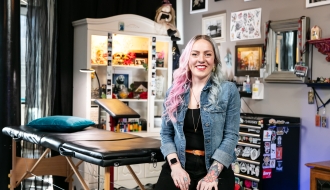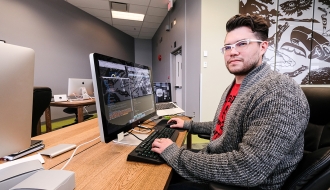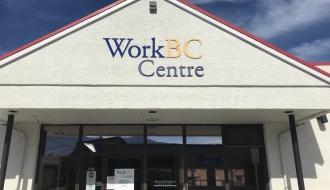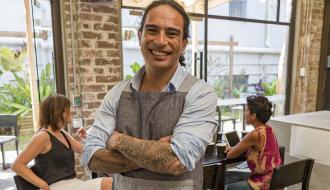Peace Warriors Providing Compassion, Love and Land Medicine

When Velma Sutherland, Band Manager for the Glen Vowell First Nation (also known as Sik-E Dakh), covered the community gate over the Christmas holidays in 2020, she noticed the anxious reaction of members when the Royal Canadian Mounted Police (RCMP) came into the small village. (Located in the northwestern part of the province on the west side of the Skeena River, between Hazelton and Kispiox.)
As the mother of two sons who are both land defenders, she has seen them violently arrested by the RCMP and “traumatized just by being peaceful protestors.” She explains how “they were stereotyped and discriminated against.”
However, she knew there needed to be a better way. Velma took it upon herself to research alternative Indigenous peacekeeping programs, discussing her work with her sons and her Elders — including her mentor, Dr. Martin Brokenleg. After consulting with her community, she reached out to Coast Mountain College — and that is how the Peace Warriors Program developed.
At first glance, it appears to be an eclectic mix of training. There was non-violent communication, trauma-informed care, swift water rescue, wilderness first aid, a study of Band bylaws and even a chainsaw safety component “because an Elder might need firewood,” explains Velma.
The focus on variety reveals the core intent of the program: to create strong connections between the Peace Warriors and their communities. Peace Warriors don’t carry weapons, and part of their training involves assessing a situation to decide if additional help is needed — from police or paramedics to other resources.
“The name took a while to come up with,” says Velma. “Warrior means to fight for something. We are fighting for peace.”
No one knows the importance of language better than Dr. Jane Smith, Xsiwis. She taught a course in the Gitxsanimx language, using prayers, songs and Gitxsan games to give the Peace Warriors confidence to speak their language — even just a little bit — when working with community members, particularly Elders. “They can greet people in their language and then switch to English,” she explains. “It changes everything. It makes everybody happier.”
Peace Warrior Marilyn Brown, Taa-bekxw, also noticed the change in dynamics generated by the program. “It offers so much opportunity to take ownership of our community, reducing situations that can get out of hand and result in the RCMP being called.”
She describes a situation where two Peace Warriors used their skills to assist a woman who didn’t want the RCMP involved in a domestic violence incident. “One got the woman to a safe place, [one] stayed on to talk to the guy and found a way to have a conversation to de-escalate the situation.”
Marilyn is a Victim Services Workers with the Northern Society for Domestic Peace. She was one of the sixteen original participants that took the program to expand her skills and to better understand the community, as she did not grow up on the reserve. She has training in Indigenous-focused trauma therapy, and she shares some of that knowledge with her fellow Peace Warriors.
“[People’s] bodies will tell us where they are,” she says, explaining that the work might involve using conversation as a ceremony on the land. For example, “we might sit on the land by the river and talk…and pick up a rock and ask them to place it on their throat as land medicine to pull out the barrier and help verbalize their pain.”
Nevada Pakka says the Peace Warrior training helped her find her voice. “I’m a soft-spoken person, and I decided it was about time to learn how to communicate with people.”
She entered the program to start anew after moving back to the reserve. “I was out of my comfort zone, but I enjoyed it a lot. The courses were very effective.”
Nevada is now working as a youth intern for the Glen Vowell Band, where she says her training in first aid and non-violent communication gave her confidence to deal with potentially challenging situations.
Several other Peace Warriors are also working for the Band, which continues to staff the community gate overnight. Velma hopes to hire more support workers to staff a mobile unit she wants to create in a newly acquired motor home. “If there’s an emergency and someone needs a safe place to go — they can go there,” she says. “It will have harm-reduction materials, like Naloxone. It will have food [and] it will have an Elder…”
One thing it won’t have: stigma. Peace Warriors’ intent is to reach out to their community with understanding, with respect and with a set of skills to proactively build peace.
Did you know that WorkBC has a list of different education and training resources for Indigenous Peoples? It includes federal, provincial and Indigenous-led programs! Check it out here.
The Ministry of Post-Secondary Education and Future Skills has invested $15 million to help Indigenous communities manage the economic impacts of COVID-19. The skills training funding goes to Indigenous training partners throughout B.C. to address COVID-19 recovery in the workforce.






